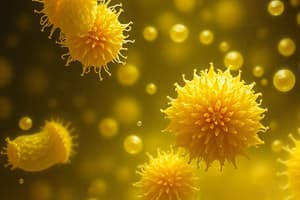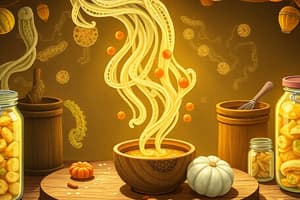Podcast
Questions and Answers
Denys associated pyogenic ______ with death of a person who ate meat prepared from a diseased cow.
Denys associated pyogenic ______ with death of a person who ate meat prepared from a diseased cow.
Staphylococcus
Marie von Ermengem isolated Bacillus botulinus (Clostridium ______) from contaminated meat and proved that it caused botulism.
Marie von Ermengem isolated Bacillus botulinus (Clostridium ______) from contaminated meat and proved that it caused botulism.
botulinum
Car Weigert used ______ blue (a synthetic dye) to stain bacteria in aqueous suspension.
Car Weigert used ______ blue (a synthetic dye) to stain bacteria in aqueous suspension.
methylene
Ferdinand Cohn showed heat resistance of Bacillus ______ endospores.
Ferdinand Cohn showed heat resistance of Bacillus ______ endospores.
Joseph Lister isolated ______ lactis in pure culture by serial dilution from sour milk.
Joseph Lister isolated ______ lactis in pure culture by serial dilution from sour milk.
Hans Christian Gram developed Gram ______ of bacterial cells.
Hans Christian Gram developed Gram ______ of bacterial cells.
In 1658, Athanasius Kircher used a ______ to observe minute living worms in putrid milk and meat
In 1658, Athanasius Kircher used a ______ to observe minute living worms in putrid milk and meat
Antony Van Leuwenhoek observed ______ in saliva, rain water, and vinegar
Antony Van Leuwenhoek observed ______ in saliva, rain water, and vinegar
Antony Van Leuwenhoek called the microorganisms he observed ______
Antony Van Leuwenhoek called the microorganisms he observed ______
Ferdinand Cohn developed a ______ classification system of bacteria
Ferdinand Cohn developed a ______ classification system of bacteria
Ferdinand Cohn discovered that some bacteria produce ______
Ferdinand Cohn discovered that some bacteria produce ______
The ______ theory suggests that life forms can emerge from non-living things
The ______ theory suggests that life forms can emerge from non-living things
Francesco Redi's experiment involved placing fresh meat in three ______
Francesco Redi's experiment involved placing fresh meat in three ______
Lazzaro Spallanzani boiled the broth and ______ the flask immediately after boiling
Lazzaro Spallanzani boiled the broth and ______ the flask immediately after boiling
Antoine Laurent Lavoisier found that ______ is necessary for life
Antoine Laurent Lavoisier found that ______ is necessary for life
Louis Pasteur discovered that bacteria could grow only if the infusions were contaminated with bacteria carried by ______ particles in air
Louis Pasteur discovered that bacteria could grow only if the infusions were contaminated with bacteria carried by ______ particles in air
______ named the microscopic organism found on the surface of wine during vinegar production as Mycoderma mesentericum.
______ named the microscopic organism found on the surface of wine during vinegar production as Mycoderma mesentericum.
In ______, PASTEUR proved that this organism was associated with the conversion of alcohol to acetic acid and named it Mycoderma aceti.
In ______, PASTEUR proved that this organism was associated with the conversion of alcohol to acetic acid and named it Mycoderma aceti.
______ renamed it Acetobacter aceti in 1898.
______ renamed it Acetobacter aceti in 1898.
Theodor Schwann named the organism involved in sugar fermentation as ______ in 1837.
Theodor Schwann named the organism involved in sugar fermentation as ______ in 1837.
Charles Cogniard-Latour suggested that growth of yeasts was associated with alcohol fermentation in ______.
Charles Cogniard-Latour suggested that growth of yeasts was associated with alcohol fermentation in ______.
In ______, Louis Pasteur showed that fermentation of lactic acid and alcohol from sugar was the result of growth of specific bacteria and yeasts, respectively.
In ______, Louis Pasteur showed that fermentation of lactic acid and alcohol from sugar was the result of growth of specific bacteria and yeasts, respectively.
Emil Hansen used pure cultures of ______ to ferment beer in 1883.
Emil Hansen used pure cultures of ______ to ferment beer in 1883.
L.Pasteur recommended heating of wine at 145 ° F (62.7°C) for 30 min to destroy ______ bacteria.
L.Pasteur recommended heating of wine at 145 ° F (62.7°C) for 30 min to destroy ______ bacteria.
Study Notes
Early Developments in Microbiology
- 8000 BC: Agriculture and animal husbandry began
- 8000-1000 BC: Many food preservation methods like smoking, fermentation, etc. emerged to prevent spoilage
- 7000 BC: Babylonians discovered beer
- 6000 BC: First study on food spoilage
- 3500 BC: Wine production started
- 3000 BC: Egyptians manufactured cheese and butter
- 1000 BC: Romans used snow to preserve shrimp, smoked and fermented meat
Development of Microscopy
- 1658: Athanasius Kircher observed minute living worms in putrid milk and meat using a microscope
- 1664: Robert Hooke described the structure of molds
- 1676: Antony Van Leuwenhoek observed bacteria in saliva, rainwater, and vinegar, and identified three morphological structures: spherical (cocci), cylindrical (bacilli), and spiral (spirilla)
Early Microbiologists
- 1700s: Francesco Redi disproved spontaneous generation theory through experiments with meat and flies
- 1731-1781: John Needham supported spontaneous generation theory, but was later disproven by Lazzaro Spallanzani
- 1861: Louis Pasteur proved that boiled infusions could grow bacteria only if contaminated with bacteria carried by dust particles in air
Food Preservation and Microbiology
- 1804: Nicolas Appert developed methods to preserve foods in sealed glass bottles by heat in boiling water
- 1819: Peter Durand developed canning preservation of foods in steel cans
- 1839: Charles Mitchell introduced tin lining of metal cans
- 1870: Louis Pasteur recommended heating wine at 145°F (62.7°C) for 30 minutes to destroy souring bacteria
- 1895: Harry Russell showed that gaseous swelling with bad odors in canned peas was due to growth of heat-resistant bacteria (spores)
Key Discoveries
- 1854: Heinrich Schröder and Theodore von Dusch used cotton to close tubes and flasks to prevent microbial contamination in heated culture broths
- 1876: Carl Weigert used methylene blue to stain bacteria in aqueous suspension
- 1877: Ferdinand Cohn showed the heat resistance of Bacillus subtilis endospores
- 1880: Robert Koch and his associates introduced solid media, Petri dish, flagellar staining, steam sterilization of media above 100°C, and photography of cells and spores
- 1884: Hans Christian Gram developed Gram staining of bacterial cells
Studying That Suits You
Use AI to generate personalized quizzes and flashcards to suit your learning preferences.
Related Documents
Description
Explore the early history of microbiology, from the development of food preservation methods to the discovery of microscopes. Learn about the contributions of ancient civilizations and early scientists.




